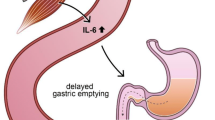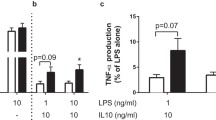Abstract
Background: Amino acids have been shown to stimulate insulin secretion and decrease glycated hemoglobin (A1C) in patients with Type 2 diabetes. In vitro, glycine reduces tumor necrosis factor (TNF)-α secretion and increases interleukin-10 secretion in human monocytes stimulated with lipopolysaccharide. The aim of this study was to determine whether glycine modifies the proinflammatory profiles of patients with Type 2 diabetes. Materials/subjects and methods: Seventy-four patients, with Type 2 diabetes were enrolled in the study. The mean age was 58.5 yr, average age of diagnosis was 5 yr, the mean body mass index was 28.5 kg/m2, the mean fasting glucose level was 175.5 mg/dl and the mean A1C level was 8%. They were allocated to one of two treatments, 5 g/d glycine or 5 g/d placebo, po tid, for 3 months. Results: A1 C levels of patients given glycine were significantly lower after 3 months of treatment than those of the placebo group. A significant reduction in TNF-receptor I levels was observed in patients given glycine compared with placebo. There was a decrease of 38% in the interferon (IFN)-γ level of the group treated with placebo, whereas that of the group treated with glycine increased up to 43%. These data showed that patients treated with glycine had a significant decrease in A1C and in proinflammatory cytokines and also an important increase of IFN-γ. Conclusion: Treatment with glycine is likely to have a beneficial effect on innate and adaptive immune responses and may help prevent tissue damage caused by chronic inflammation in patients with Type 2 diabetes.
Similar content being viewed by others
References
van Loon LJ, Kruijshoop M, Menheere PP, Wagenmakers AJ, Saris WH, Keizer HA. Amino acid ingestion strongly enhances insulin secretion in patients with long-term type 2 diabetes. Diabetes Care 2003, 26: 625–30.
González-Ortiz M, Medina-Santillán R, Martinez-Abundis E, von Drateln CR. Effect of glycine on insulin secretion and action in healthy first-degree relatives of type 2 diabetes mellitus patients. Horm Metab Res 2001, 33: 358–60.
Gannon MC, Nuttall JA, Nuttall FQ. The metabolic response to ingested glycine. Am J Clin Nutr 2002, 76: 1302–7.
Alvarado-Vásquez N, Zamudio P, Cerón E, et al. Effect of glycine in streptozotocin-induced diabetic rats. Comp Biochem Physiol C Toxicol Pharmacol 2003, 134: 521–7.
Carvajal-Sandoval G, Juárez E, Ramos Martínez G, Carvajal-Juárez ME, Medina-Santillán R. Inhibition of hemoglobulin glycation with glycine induced diabetes mellitus in rats. Proc West Pharmacol Soc 1999, 42: 35–6.
Alvarado-Vásquez N, Lascurain R, Cerón E, et al. Oral glycine administration attenuates diabetic complications in streptozotocin-induced diabetic rats. Life Sci 2006, 79: 225–32.
Spittler A, Reissner CM, Oehler R. Immunomodulatory effects of glycine on LPS-treated monocytes: reduced TNF-alpha production and accelerated IL-10 expression. FASEB J 1999, 13: 563–71.
Zhong Z, Wheeler MD, Li X, et al. L-Glycine: a novel anti-inflammatory, immunomodulatory and cytoprotective agent. Curr Opin Clin Metab Care 2003, 6: 229–40.
Duncan BB, Schmidt MI, Pankow JS, et al. Low-grade systemic inflammation and the development of type 2 diabetes: the atherosclerosis risk in communities study. Diabetes 2003, 52: 1799–805.
Tripathy D, Mohanty P, Dhindsa S, et al. Elevation of free fatty acids induce inflammation and impairs vascular reactivity in healthy subjects. Diabetes 2003, 52: 2882–7.
Chu NF, Spiegelman D, Rifai N, Hotamisligil GS, Rimm EB. Glycemic status and soluble tumor necrosis factor receptor levels in relation to plasma leptin concentrations among normal weight and overweight US men. Internat J Obes Relat Metabol Disor 2000, 24: 1085–92.
Laaksonen DE, Niskanen L, Nyyssönen K, et al. C-reactive protein and the development of the metabolic syndrome and diabetes in middle-aged men. Diabetologia 2004, 47: 1403–10.
Müller S, Martin S, Koenig W, et al. Impaired glucose tolerance is associated with increased serum concentrations of interleukin 6 and co-regulated acute-phase proteins but not TNF-alpha or its receptors. Diabetologia 2002, 45: 805–12.
Fernández-Real JM, Broch M, Ricart W, et al. Plasma levels of the soluble fraction of tumor necrosis factor receptor 2 and insulin resistance. Diabetes 1998, 47: 1757–62.
Dzienis-Straczkowska S, Straczkowski M, Szelachowska M, Stepien A, Kowalska I, Kinalska I. Soluble tumor necrosis factor-alpha receptors in young obese subjects with normal and impaired glucose tolerance. Diabetes Care 2003, 26: 875–80.
Hu FB, Meigs JB, Li TY, Rifai N, Manson JE. Inflammation markers and risk of developing type 2 diabetes in women. Diabetes 2004, 53: 693–700.
Weyer C, Yudkin JS, Stehouwer CD, Schalkwijk CG, Pratley RE, Tataranni PA. Humoral markers of inflammation and endothelial dysfunction in relation to adiposity and in vivo insulin action in Pima Indians. Atherosclerosis 2002, 161: 233–42.
Tsiavou A, Degiannis D, Hatziagelaki E, Koniavitou K, Raptis SA. Intracellular IFN-gamma production and IL-12 serum levels in latent autoimmune diabetes of adults (LADA) and in type 2 diabetes. J Interferon Cytokine Res 2004, 24: 381–7.
Tsiavou A, Hatziagelaki E, Chaidaroglou A, Koniavitou K, Degiannis D, Raptis SA. Correlation between intracellular interferon-gamma (IFN-gamma) production by CD4+ and CD8+ lymphocytes and IFN-gamma gene polymorphism in patients with type 2 diabetes mellitus and latent autoimmune diabetes of adults (LADA). Cytokine 2005, 31: 135–41.
El Hafidi M, Pérez I, Baños G. Is Glycine effective against elevated blood pressure? Curr Opin Clin Nutr Metab Care 2006, 9: 26–31.
Matthews DR, Hosker JP, Rudenski AS, Naylor BA, Treacher DF, Turner RC. Homeostasis model assessment: insulin resistance and beta-cell function from fasting plasma glucose and insulin concentrations in man. Diabetologia 1985, 28: 412–9.
Andrade SE, Walker AM, Gottlieb LK, et al. Discontinuation of antihyperlipidemic drugs-do rates reported in clinical trials reflect rates in primary care settings? N Engl J Med 1995, 332: 1125–31.
Esposito K, Nappo F, Marfella R, et al. Inflammatory cytokine concentrations are acutely increased by hyperglycemia in humans: role of oxidative stress. Circulation 2002, 106: 2067–76.
Kusminski CM, McTernan PG, Kumar S. Role of resistin in obesity, insulin resistance and Type II diabetes. Clin Sci (Lond) 2005, 109: 243–56.
Slomowitz LA, Deng A, Hammes JS, Gabbai F, Thomson SC. Glomerulotubular balance, dietary protein, and the renal response to Glycine in diabetic rats. Am J Physiol Regul Integr Comp Physiol 2002, 282: R1096–103.
Zelvyte I, Dominaitiene R, Crisby M, Janciauskiene S. Modulation of inflammatory mediators and PPARgamma and NF-kappaB expression by pravastatin in response to lipoproteins in human monocytes in vitro. Pharmacol Res 2002, 45: 147–54.
Matilla B, Mauriz JL, Culebras JM, Gonzalez-Gallego, Gonzalez P. La glicina: un antioxidante protector celular. Nutr Hosp 2002, 1: 2–9.
Bierhaus A, Schiekofer S, Schwaninger M, et al. Diabetes-associated sustained activation of transcription factor nuclear factor-kappa B. Diabetes 2001, 50: 2792–808.
Author information
Authors and Affiliations
Corresponding author
Additional information
These authors contributed equally.
Rights and permissions
About this article
Cite this article
Cruz, M., Maldonado-Bernal, C., Mondragón-Gonzalez, R. et al. Glycine treatment decreases proinflammatory cytokines and increases interferon-γ in patients with Type 2 diabetes. J Endocrinol Invest 31, 694–699 (2008). https://doi.org/10.1007/BF03346417
Accepted:
Published:
Issue Date:
DOI: https://doi.org/10.1007/BF03346417




